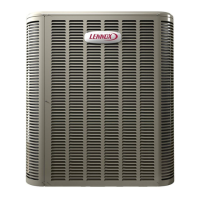
Do you have a question about the Lennox 16ACX Series and is the answer not in the manual?
| Stages | Single-stage |
|---|---|
| Refrigerant | R-410A |
| Cooling Capacity | 1.5 to 5 tons |
| Efficiency | Up to 17 SEER |
| HSPF | 9.50 |
| Heating Capacity | 1.5 to 5 tons |
| Warranty | 10-Year Limited Warranty on compressor |
Specifies recommended torque values for various fasteners used in unit servicing.
Guidance on selecting and using manifold gauge sets suitable for HFC-410A systems.
Explains the function of liquid and vapor line service valves for system maintenance.
Step-by-step instructions for operating angle type service valves for system access.
Step-by-step instructions for operating ball type service valves for system access.
Procedure for safely accessing the service port, including cap removal and gauge connection.
Instructions for correctly reinstalling stem caps after service, including torque specifications.
Factors to consider when positioning the unit, including sound ordinances and window placement.
Guidelines for placing the unit on a slab, ensuring proper drainage and slope tolerance.
Details on field refrigerant piping, types of Lennox line sets, and field-fabricated options.
Guidance on compatibility between the outdoor unit and indoor coils/line sets, especially regarding metering devices.
Methods for isolating vertical refrigerant lines transitioning to a horizontal run.
Techniques for properly installing and insulating vertical refrigerant line runs.
Guidance on properly supporting and isolating horizontal refrigerant line runs.
Allow braze joint to cool before removing wet rag; temperatures above 250°F damage valve seals.
Specifies recommended silver alloy brazing rod percentages for different metal combinations.
Warning about fire and explosion hazards associated with using oxygen with refrigeration lines.
Instructions for cutting and deburring refrigerant line ends to ensure a proper connection.
Procedure for safely removing service port caps and valve cores before brazing.
Detailed steps for connecting manifold gauges and using nitrogen for brazing.
Instructions for wrapping service valves and tube stubs with water-saturated cloths during brazing.
Procedure for flowing nitrogen through the system during brazing to prevent oxidation.
Steps for brazing the line set, including wrapping valves and cooling the joint.
Final steps after brazing, including disconnecting gauges and removing cloths.
Steps for removing a fixed orifice metering device from an existing indoor coil.
Steps for removing an expansion valve metering device from an existing indoor coil.
How to connect gauges and equipment for the refrigerant flushing procedure.
Procedure for flushing the line set and indoor unit coil using HCFC-22 refrigerant.
Step-by-step guide for installing the expansion valve unit, internal or external to the coil.
Procedure for installing the equalizer line connection on the vapor line.
Guidance on proper orientation and installation of the sensing bulb for the expansion valve.
Steps for connecting the HFC-410A manifold gauge set to the system for leak testing.
Detailed procedure for pressurizing the system with refrigerant/nitrogen and checking for leaks.
Connecting the manifold gauge set, micron gauge, and vacuum pump for evacuation.
Steps for evacuating the system to the required micron level and verifying leak integrity.
Specifies the transformer requirements for low-voltage control power in the system.
Recommendations for thermostat installation location and orientation for accurate readings.
Important note regarding conductor type, circuit ampacity, and overcurrent protection size.
Critical safety warning about electrical shock hazard and the necessity of proper grounding.
Details the function of key unit components such as the internal vacuum protector and filter drier.
Description of the filter drier's role in system cleanliness and the requirements for replacement.
Explanation of the auto-reset low pressure switch function and its operating parameters.
Details the auto-reset high pressure switch function and its trip pressure settings.
Explains the function of the crankcase heater and its control via the thermostat switch.
Description of the compressor-mounted thermal switch that prevents overheating.
Lists maintenance checks to be performed by a qualified installer or service agency.
Tasks for maintaining the outdoor unit, including cleaning the coil and checking wiring.
Specific care instructions for the outdoor coil, especially in corrosive environments like coastal areas.
Maintenance tasks for the indoor unit, covering filters, motors, and coils.
Guidance on replacing disposable air filters with the correct type and size.
Instructions for cleaning and maintaining reusable foam air filters.
Information for systems equipped with an electronic air cleaner for particle removal.
Details on the indoor unit's evaporator coil, drain pan, and condensate line maintenance.
Directs users to the thermostat homeowner manual for operating instructions.
Checks to perform before calling for service, including thermostat settings and fuses.
Homeowner guidance on outdoor coil cleaning and keeping the unit free of obstructions.
General advice on maintaining peak system performance through regular upkeep.
Instructions for locating, checking, cleaning, or replacing the system's air filter.
A checklist to verify proper installation and system performance before final operation.
